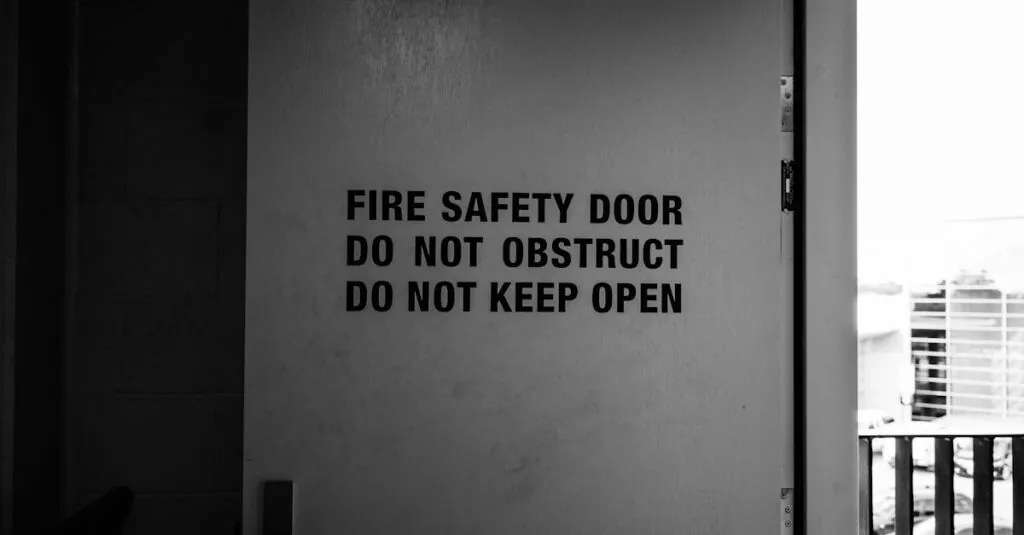When the lights go out and the storm rages on, the last thing anyone wants is to fumble around in the dark looking for the emergency generator. Accessing that lifesaving machine shouldn’t feel like a scene from a horror movie. With a little planning and some clever strategies, getting to your generator can be as easy as pie—or at least easier than finding your phone charger when you’re about to miss an important call.
Imagine this: power’s out, the fridge is warming up, and your favorite binge-worthy show is just a click away from being interrupted indefinitely. By ensuring quick and hassle-free access to your generator, you can save the day and keep the good times rolling. Let’s dive into some practical tips that’ll make sure you’re never left in the dark—because nobody looks good in candlelight.
Table of Contents
ToggleImportance Of Emergency Generator Access
Easy access to emergency generators remains crucial during power outages, particularly in severe weather. Proper planning can facilitate quick retrieval, reducing stress during outages.
Reliability During Power Outages
Reliable power sources significantly impact comfort during outages. Emergency generators provide essential electricity for critical appliances like refrigerators and medical devices. Quick access ensures that backup power kicks in without delay. Predictable response during emergencies decreases disruption, allowing individuals to focus on maintaining normalcy. Access to generators becomes even more critical during prolonged outages, ensuring households remain secure and operational.
Safety Considerations
Safety must always be a priority when accessing emergency generators. Proper placement of generators prevents hazards like carbon monoxide poisoning and electrical accidents. Choosing a well-ventilated location minimizes risks while allowing for quick operation. During inclement weather, securing the generator against physical damage becomes essential. Keep necessary tools and materials nearby to streamline setup and avoid unsafe improvisation. Understanding the generator’s operational requirements contributes to overall safe usage, ensuring peace of mind during emergencies.
Types Of Emergency Generators
Emergency generators come in various types, each designed to meet specific needs during power outages. Understanding these types helps individuals choose the most suitable option for their situations.
Portable Generators
Portable generators offer mobility and flexibility. They typically operate on gasoline or propane, supplying power to essential appliances during outages. Easy to store and transport, these generators work well for temporary, short-term power needs. Many feature multiple outlets, allowing users to connect various devices simultaneously. Weighing between 50 and 300 pounds, they can fit in limited spaces but require safe placement outdoors to avoid carbon monoxide buildup.
Standby Generators
Standby generators provide automatic backup power for homes during outages. These units connect directly to a property’s electrical system, turning on within seconds of detecting a power failure. Running on natural gas or propane, standby generators can power a home’s entire electrical load or just essential appliances, depending on the model. They require professional installation but offer peace of mind by operating quietly and automatically whenever needed. Proper maintenance ensures reliable performance year-round.
Factors To Consider For Emergency Generator Access
Easy access to emergency generators requires careful consideration of various factors, ensuring effectiveness during outages.
Location And Placement
Selecting the right location for a generator significantly impacts its performance. Generators must sit outside, which avoids accumulating dangerous carbon monoxide. Placing the generator at least 15 feet away from windows and doors prevents fumes from entering the home. Accessibility for refueling and maintenance matters too; a flat, stable surface provides stability during operation. Protecting the generator from harsh weather conditions also plays a vital role. Installing a shelter can shield it from rain or snow. Maintaining clear paths to this location simplifies access in emergencies.
Fuel Availability
Fuel availability is critical for efficient generator operation. Generator owners should stock enough fuel to power the unit through extended outages. Storing gasoline or propane safely and securely prevents contamination and accidents. Establishing partnerships with local suppliers ensures quick top-ups when supplies run low. Powering a generator typically requires a specific fuel type; knowing the chosen generator’s fuel needs will guide storage decisions. Regularly checking and rotating stored fuel ensures it stays fresh during emergencies. Overall, reliable fuel access enhances the generator’s responsiveness during power failures.
Best Practices For Emergency Generator Access
Easy access to emergency generators during power outages requires adherence to best practices. Following specific guidelines ensures safety and efficiency.
Regular Maintenance
Routine maintenance boosts the reliability of emergency generators. Schedule inspections every six months, focusing on essential components like oil levels and filters. Clean the generator regularly, removing any debris that might obstruct airflow. Keep the battery charged to ensure it responds promptly during outages. Additionally, testing the generator under load can confirm its operational status. Fuel should also be checked and rotated to prevent degradation. Following these maintenance steps fosters trust in the generator’s performance during critical moments.
Training And Safety Procedures
Training individuals on generator operations enhances safety and efficiency. Familiarizing everyone with proper startup and shutdown procedures is crucial. Conduct training sessions on handling fuel safely, emphasizing the need for outdoor refueling to minimize risks. Discuss the signs of carbon monoxide buildup and the importance of proper ventilation. Equip users with emergency shutdown procedures to handle any malfunctions. Regularly reviewing these protocols ensures readiness for unexpected situations. Proper training ultimately promotes a safe environment while utilizing emergency generators.
Conclusion
Ensuring quick access to emergency generators is essential for maintaining comfort and safety during power outages. By implementing effective planning and preparation strategies individuals can streamline the retrieval process and minimize stress when the lights go out.
Choosing the right generator type and maintaining it properly not only enhances reliability but also empowers households to respond swiftly to emergencies. With a focus on safety and accessibility individuals can navigate power failures with confidence knowing they have a reliable backup solution ready at hand. Prioritizing these practices fosters peace of mind and ensures preparedness for any unforeseen circumstances.








